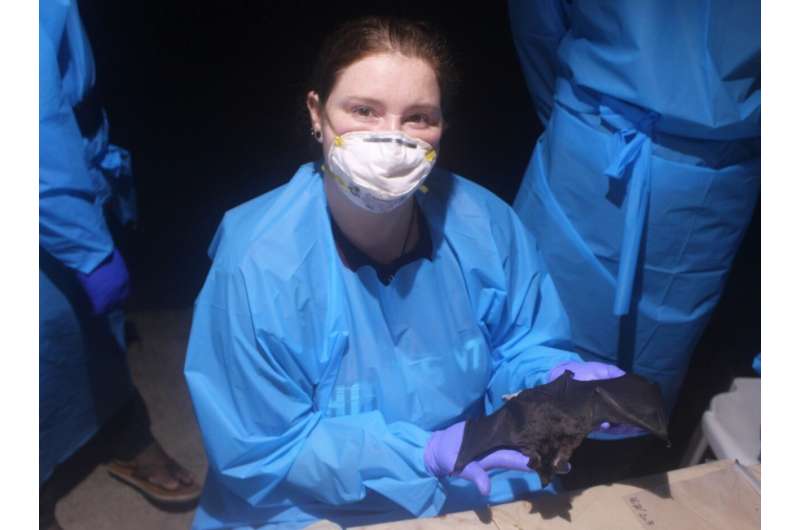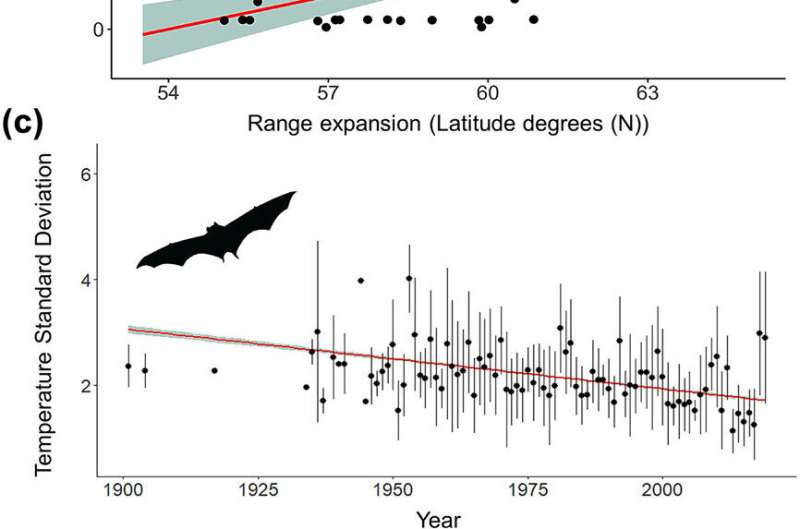This article has been reviewed according to Science X's editorial process and policies. Editors have highlighted the following attributes while ensuring the content's credibility:
fact-checked
peer-reviewed publication
trusted source
proofread
Research links climate change to vampire bat expansion and rabies virus spillover

Vampire bats may soon take up residence in the United States and bring with them an ancient pathogen. "What we found was that the distribution of vampire bats has moved northward across time due to past climate change, which has corresponded with an increase in rabies cases in many Latin American countries," said Paige Van de Vuurst, a Ph.D. student in Virginia Tech's Translational Biology, Medicine, and Health Graduate Program.
Van de Vuurst is the lead author of research recently published in Ecography that predicts that vampire bats—currently only found in Mexico and Central and South America—are on the move, with the United States being a viable home in 27 years. The findings concluded that with shifting seasonality—the differences in temperature between the coldest and warmest seasons—vampire bats have expanded their locations in search of more stable, temperate climates.
The research team, which included both undergraduate and graduate students, also found this expanded reach could be linked to a spillover of rabies. Vampire bats are known carriers of rabies, a disease known for its high mortality rates and often considered the oldest pathogen known by humans, dating back 3,000 years.
Latin America is currently feeling the bite of the rabies spread through the loss of livestock, which has generated fear as the bats' migration patterns expand. The Virginia Tech team aims to vigorously identify and track the bats by traveling to Colombia to help contain the spread to other countries, including the United States and its vital cattle industry.
Why Colombia?
"Colombia is a mega-diverse country, making it a perfect natural laboratory," said Luis Escobar, assistant professor in the Department of Fish and Wildlife Conservation in the College of Natural Resources and Environment. The country boasts having the highest number of hummingbirds and bats, attributed to its tropic climate and proximity to the equator.
Collaborating with three local universities—University of La Salle, Universidad Distrital, and Universidad del Tolima—the collective team traveled all across Colombia to collect more than 70 samples of bat species. This included a range of geographic and climate changes, starting in the hot and humid jungles to cold and cloudy parts of the Andes Mountains that are only accessible by cable car. This allowed the team to secure a variety of samples and observe how changes in climate can change the emergence of diseases in bats.
The team also explored places in Colombia that were previously closed to scientists, including Chaparral, a municipality in the Tolima region that was allowed to start welcoming tourists after the 2016 peace agreement.
The team's research sought to address a knowledge gap that limits the understanding of the spread of rabies and its spillover from wildlife to humans. Their work had three primary aims:
- Determine the role of habitat and virus mutation on rabies spillover to humans and livestock across Latin America
- Identify the effect of changes in biodiversity in rabies virus spillover
- Investigate geographic and environmental factors influencing the spread of bat-borne

Sinking teeth into the experience
This field experience allowed four undergraduate and two graduate students to travel to Colombia. Van de Vuurst led the team's campuswide recruitment efforts, yielding 30 interested students from across disciplines.
In advance of the trip to Colombia to study vampire bats, Escobar and his team met near the Duck Pond to review critical safety information and field sampling protocols.
"We selected a truly stellar group of students, and I could not be prouder of them," said Van de Vuurst.
She was provided an opportunity as an undergraduate to go on an international excursion to Peru. "That trip changed my life, and really opened up the world of ecology for me. I am so glad that we were able to offer that same kind of once in a lifetime research experience to so many students through Luis' hard work and generosity."
For undergraduate Julia Alexander, it was a series of firsts, including first field experience, first time on a plane, and first time out of the country.
As part of the Escobar Lab's research staff, Alexander was able to study disease transmission in vampire bats and other local bat species, working with local communities in the Tolima region. It was critically important for Escobar and Van de Vuurst to be able to offer the international research opportunity, knowing that undergraduate students are not usually able to participate in such an experience.
"I not only learned valuable field skills for my career, but also important life lessons from every challenge faced," Alexander said. "Although this journey was not easy, I wouldn't exchange the experience for anything else."
Crossing borders to collaborate
The value of building a network of international collaboration cannot be understated, especially in terms of the commonalities of technology, facilities, and students between Virginia Tech and their international partners.
In fact, Escobar is hosting Diego Soler-Tovar, assistant professor from Universidad La Salle, who will be working in the Escobar lab through late January 2024, to study the drivers of rabies spread in Latin America.
"We all have one goal: generating samples, new data, and new knowledge," Escobar said.
More information: Paige Van de Vuurst et al, Climate change linked to vampire bat expansion and rabies virus spillover, Ecography (2023). DOI: 10.1111/ecog.06714
Journal information: Ecography
Provided by Virginia Tech


















